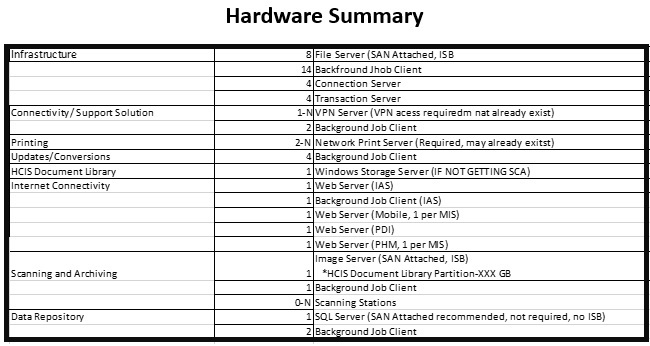Difference between revisions of "MEDITECH 6.x Migration- Infrastructure and Planning"
| Line 2: | Line 2: | ||
==Introduction== | ==Introduction== | ||
| − | There is a lot to consider when migrating from MAGIC or Client/Server (C/S) 5.X to MEDITECH's 6.x. Infrastructure requirements are | + | There is a lot to consider when migrating from MAGIC or Client/Server (C/S) 5.X to MEDITECH's 6.x. Infrastructure requirements,financial restraints, as well as staffing are some of the important components of your migration journey. The following will hopefully assist in some of the decisions needed to ensure a successful migration to 6.x |
==Data Center Upgrade/Planning== | ==Data Center Upgrade/Planning== | ||
Revision as of 20:44, 10 February 2016
Introduction
There is a lot to consider when migrating from MAGIC or Client/Server (C/S) 5.X to MEDITECH's 6.x. Infrastructure requirements,financial restraints, as well as staffing are some of the important components of your migration journey. The following will hopefully assist in some of the decisions needed to ensure a successful migration to 6.x
Data Center Upgrade/Planning
- Use strategic capacity planning to future-proof your data center's virtualization efficiency and make the most of server hardware. Create a detailed inventory. Review current servers, 6.x uses a new category of servers for journaling transactions. Best practice suggests building either a Tier 3 or Tier 4 level of physical and network redundancy. Reliable power supply ensured via grid sectors to avoid surges and ensuring basic principles and best practices of data center airflow management also will assist in a successful approach to migration.
- WAN connections, increasing the bandwidth
- Wireless Network, are you running 802.11 a/b/g/n? Higher speeds are always desirable.
- Storage-As applications become more robust, storage needs will also grow. If you already don't have, you will need a SAN.
- Back-Up -ISB (Integrated Serverless Backup) is used by 6.x for more efficient backup and recovery
- Example Hardware Summary
Dictionary Management Tool, Workflow and Task Automation Technology
Dictionary clean-up very important prior to migration to 6.x. Synchronizing and updating dictionaries, reach out to vendors ahead of time so they can plan accordingly. Workflow and task Automation Technology (scripting) for data migration and improved processes.
Interfaces
- Custom Interfaces- If you have custom interfaces, what are their roles with 6.x?
- Review all departments expectations with interfacing
- Interface differentiators with 6.x (ADT 2.1 to 2.4)
Downtime Procedures/Business Continuity/Disaster Recovery
Have documented policies and procedures for both clinical and non-clinical departments. Some questions to ask- Do we have documented downtime policies and procedures and are they readily available in the clinics/departments? Is staff well versed in downtime procedures? Is unscheduled downtime handled differently than scheduled downtime? There are many tools that can be used for business continuity in the event of system downtime. These tools can greatly assist an organization in seeing patients during downtime by providing the pertinent patient health information from a patient chart to provide optimal patient care when the EHR is not available. VitalCenter
Implementation Time Line/Change Management
Plan for 1-3 years depending on the size of your organization. Planning begins with Project Governance creation and Project Definition. A 6.x migration is similar to a net new implementation and requires the same time and resources as a new installation. Cultural change process needs physician buy in and engagement. Take into consideration workflow documentation and current state and gap analysis. Do not downplay the importance of training both clinical and nonclinical staff. Prior to go-live, have in place your EHR Steering Committee and physician champions to assist with clinical decision making. Have a procedure in place that allows for changes to occur following a quick review process.
Tips and Tricks
- Create your own training material based on YOUR system and YOUR system preferences. This will also help in testing YOUR system.
- For your FTP scheduled jobs, know what 6.x offers and identify any gaps and what is needed to fill those gaps prior to go-live.
- TESTING TESTING TESTING- test out likely and unlikely scenarios and build in Test and then in Production.
- Understand Charge process/Charge capture to assist in appropriate build to prevent financial issues after go-live.
- If you use a third party or add on vendor for dispersing clinical reports, a few items to keep in mind:
-The MEDITECH C/S 6.x is a completely different HCIS and does process reports differently from MAGIC. Modifications will need to be made to ensure that reports are processed properly.
-Windows printers need to be configured to receive reports for C/S 6.x. C/S 6.x does not have embedded printing routines.
-Review your report distribution templates and make necessary changes so that C/S 6.x reports are properly processed.
-Prior to processing reports generated by the C/S 6.x system, import a MIS provider dictionary from the C/S HCIS.
